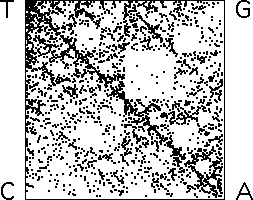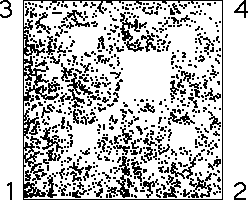

We begin by reviewing
| the Chaos Game and |
| IFS |
A natural question, as far as we know first posed by Ian Stewart, is what picture does the Random IFS Algorithm generate if the driving sequence is not random? Not surprisingly, the answer depends on how the sequence departs from randomness. We consider three general types of departures:
| (1) the transformations are applied in a cycle - a pattern that repeats, in principle forever |
| (2) the transformations can be applied in any order, except some combinations are forbidden |
| (3) the transformations are applied in an order imposed by some data: the stock market, daily temperatures, daily output of a dairy farm, word-use patterns in a text, or DNA sequences, for example. |
First, we establish the IFS used. Stewart initially asked the nonrandomness question for a Sierpinski gasket IFS. We prefer the IFS
| T1(x, y) = (x/2, y/2) |
| T2(x, y) = (x/2, y/2) + (1/2, 0) |
| T3(x, y) = (x/2, y/2) + (0, 1/2) |
| T4(x, y) = (x/2, y/2) + (1/2, 1/2) |
used to introduce addresses. The reason is simple: driven by a uniform random sequence, the Random IFS Algorithm fills in the unit square uniformly. Departures from uniform randomness are revealed by departures from unit fill. We take (.5, .5) as the initial point.
To motivate this excursion, here is an example first explored by H. Joel Jeffrey. The genetic code is written in an alphabet of four characters: C, A, T, and G. A sequence of several billion of these makes each of us. A sequence of 3957 symbols is needed to encode the formation of the enzyme amylase. How can we convert a DNA sequence into an IFS picture? Read the sequence in order, and apply T1 whenever C is encountered, T2 for A, T3 for T, and T4 for G (for example). On the left is the picture that results. On the right is a picture that results when 3957 points are generated randomly, except that T4 never immediately follows T1.

| 
|
Not an exact match, but certainly suggestive. Here are a few more examples. With this motivation, consider three types of driven IFS.
Driven IFS with forbidden combinations